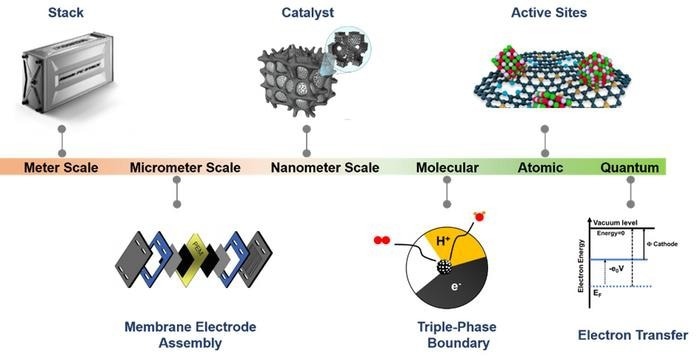Proton exchange membrane fuel cells (PEMFC) have garnered much attention due to their low environmental pollution, high conversion efficiency, and high specific energy, which can be largely employed in vehicles like airplanes, automobiles, and stationary power stations.

Carbon-based catalysts as the potential substitutes for noble metal ones in electrocatalytic oxygen reduction reaction (ORR), have received much research attention. This review introduced the ORR mechanism, analyzed the challenges faced, and discussed the strategies for designing and introducing active sites, enhancing catalyst stability, as well as forming porous structures in carbon-based catalysts. Image Credit: Chinese Journal of Catalysis
In membrane electrode assembly (MEA), the cathodic and anodic electrochemical catalysis processes are primarily composed of unit steps like species adsorption and desorption, liquid-phase mass transfer, electron transfer, and surface transformation that happen in series at the electrode interface.
It indicates that electrochemical catalysis is a complex system that would include multiple scales in space and time: catalyst and proton conductor at the nanometer scale; active sites at the atomic scale; electron transfer at the quantum scale; the triple phase boundary and the electrocatalytic ORR mechanism at the molecular level; the catalytic layer and MEA at the micrometer scale; and the fuel cell stack at the meter scale.
Each of the scales, in particular, could have a significant impact on the electrochemical ORR process and cell performance. Thus, understanding the properties and behavior at each scale is critical for considerably improving electrocatalytic performance. The catalyst design at the nanometer scale has gotten a lot of interest.
Recently, a study group spearheaded by Prof. Zidong Wei and Jing Li from Chongqing University in China described significant breakthroughs in carbon-based ORR catalysts based on mechanistic understanding and porous structure. The review was published in the Chinese Journal of Catalysis.
Because of their exceptionally high-cost effectiveness, developing carbon-based catalysts adds to the large-scale use of fuel cells and metal-air batteries. This study highlighted the development of research on carbon-based catalysts in terms of active site manufacturing, catalytic stability, and strategies for producing porous structures. The most common ways for generating active sites in metal-containing carbon-based catalysts are atomic-scale dispersion and doping.
Heteroatomic doping is a common method for creating active sites in metal-free carbon-based catalysts. We then investigated the causes of catalyst deactivation and how to increase the catalysts’ stabilities and anti-poisoning qualities. Finally, because porous structures influence active site exposure and mass transfer, the impacts of different porous structures on ORR and preparation procedures of micro-, meso-, and macroporous carbon materials were reviewed.
Journal Reference
Zhang, W., et al. (2023). Carbon-based catalysts of the oxygen reduction reaction: Mechanistic understanding and porous structures. Chinese Journal of Catalysis. doi.org/10.1016/S1872-2067(23)64427-4.